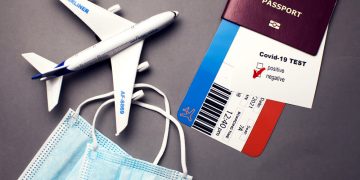Photo by Damir Spanic on Unsplash
Wander and Experience is reader-supported. When you buy through links on our site, we may earn an affiliate commission.
One of the most challenging aspects of world travel is getting your sleep patterns in line after you land at your destination and again after you return home. Jet lag is like the kryptonite of travelers: weakening you, clouding your head, making you tired early, and awake late.
The best of us can shrug jet lag off and carry on with the itinerary. But, unfortunately, the worst of us can be dominated by having a foggy head and never seem to shake that tired feeling in our eyes.
Is jet lag a real thing?
Yes, it is very much a real thing. Jet lag happens when your natural circadian rhythm is altered from quickly traveling across time zones, requiring your body to adjust to the new daylight hours. Effectively this means your body clock has not modified its sleep and wake times to match the natural environment around it. The more significant the changes in time zones, the more severe the jet lag can be, with intercontinental travel seeing the most significant impact.
Interestingly enough, the name and association with air travel comes from the fact that the jet age of air travel has made the effects of jet lag a common occurrence. Theoretically, before air travel, speeds were so slow that it would have been difficult to severely feel the effects of the time zone changes.
How long does jet lag last?
While this varies depending on the individual, most people will take one day to adjust per time zone, with the effects typically waning after a week but possibly lasting up to a few weeks. Given that this is not a permanent disorder, naturally, everyone’s body will readjust to the daylight hours of their new environment over time.
How to Manage Jet Lag
Many articles in magazines or posts online talk about beating jet lag. However, the reality is that there is no way to beat it; the goal is only to not lose too much to it, making it essential to take steps to manage jet lag within your plans and ensure it doesn’t impact your trip too much.
Arrival Day Strategy
Having a good arrival day strategy is the most crucial part of managing jet lag. For transcontinental and red-eye flights, the arrival day can often challenge your sleep habits from the fact that your night may have been spent attempting to sleep upright in an economy seat. However, by creating the right plan on the first day, you will set yourself up for the rest of the trip.
The primary goal of the arrival day strategy should be getting to bed the first night at an appropriate time. Typically on the first day after an overnight or long flight, you will be overtired and can easily sleep for a whole night regardless of what time you go to sleep. Therefore, the critical consideration is delaying your bedtime to the point where you can wake up at a regular local time in the morning.
If you are overtired and go to bed at 5 pm, you are likely to wake up early, around 1 or 2 am, when it is more challenging to find places open for breakfast for a few hours and leave you bored and waiting for the day to start. This also doesn’t set you up nicely for getting to bed at a reasonable time the following evening, leaving you tired again in the afternoon the next day.
Depending on the length of your flight, the time change, and how long you have gone without sleeping in a bed, it may make sense for you to take a nap for one to two hours to refresh and make sure you can stay up until a regular time that evening. While long afternoon naps after your first day in the new location can lengthen the effects of jet lag, if it is following a red-eye flight, it can be helpful to get you through the first day.
If you plan to take a morning nap after a red-eye flight, make sure to reach out to your hotel to confirm you can check-in early. Many frustrated travelers have arrived hoping for sleep to find out the hotel is holding firm to their 3 pm check-in policy.
Arrival Day Itinerary
While common sense would dictate that you will be tired and cannot concentrate if you do not get a good night of sleep, this is often overlooked when planning a trip. So often, the excitement gets the best of us, and we plan too ambitious of an itinerary for a day when we will clearly be tired.
Under the assumption that you will be fatigued on the first day, it is best to plan activities that you can still do while not at a hundred percent. Avoid museums and attractions that require your full attention. Spend time outside and in daylight where possible, so your body can recognize the sunlight and adjust itself to the time zone.
Often doing activities where you can walk around, take in some scenery, check out the local architecture, or browse some shops makes for the best option, with limited attention span and concentration required. Its also recommended to make the itinerary light on activities and slow-paced to save the top attractions for the following days of the trip. The goal should be to not waste the day while also doing enough to get to the evening while awake.
It is essential not to lay down until you are ready to go to sleep in the evening. Laying down in a hotel bed at 7 pm and planning on watching television until 10 pm can easily result in you falling asleep in 15 minutes and waking up in the middle of the night with the lights and TV still on, leaving you to wonder when you fell asleep. Planning a post-dinner activity that can keep you from sleeping too early is key to avoiding your next morning starting at 3 am, even if it is an evening stroll or sitting, taking in an interesting view and people watching.
Planning your itinerary
From the second day of a trip and after, the effects of jet lag usually start to become evident. Even if you get a normal night of sleep the first night and wake up at a regular time in the morning, you can often see yourself getting tired in the late afternoon or earlier than you usually would.
It’s from the second day and that being prepared with the different jet lag tips from this guide starts to pay off. It also remains essential to plan your itinerary with jet lag in mind and keep some of your options open. Depending on the timezone difference you are dealing with, you could find yourself struggling to fall asleep and wake-up, or falling asleep as soon as you hit the bed and waking up early. Have some activities in mind to do late at night if you can’t fall asleep or in the early morning if you can’t wake up. This can ease the frustration of being bored during a time you thought you’d be sleeping.
When traveling with a partner or friend, or even a family or larger group, the impact of jet lag will often vary across individuals and a wider group. Keeping two itinerary options in mind will make it easier for everyone to enjoy the mornings and evenings of a trip. Naturally, some may cope better, and depending on the circumstances, you may need to plan for people who wake up early and others who stay up later.
Generally, busier itineraries that require more physical exertion like exercise or walking are more likely to lessen the effect of jet lag. Relaxing at a resort, lying on a beach all day, and taking a mid-day nap is more likely to result in nights with less than optimal sleep. If you find yourself relaxing for an extended portion of the day, at the time that you start to feel tired mid-day, it’s best to get up and start moving around to fight the urge to nap, unless that is part of the point of the vacation.
The Return Home
After you return home from a trip across timezones, you may find that you have an even more significant challenge readjusting back to your home timezone. Trips longer than a week can often leave you adjusted to your new surroundings, and upon return, you need to adjust back.
The advice provided for your journey applies the same when you return home, but the additional challenge is that often you are back into your standard routine, where the effects of jet lag become much more apparent. For example, when you were on vacation, you may have had busy and exciting days to keep you awake and alert until you went to bed. Upon your return home, making sure you go to bed at a typical time will help you adjust far quicker than just going to bed when tired.
When getting back to a regular routine, you are likely to become tired in the mid-afternoon, at which point it helps to get up and move around. Additionally, eating your meals at standard times and allowing the sun to naturally wake you up will also help get you back to normal.
Working with Jet Lag
The above advice primarily applies to traveling for pleasure. When working in a different timezone, the flexibility of your schedule may be restricted by appointments. While your plan may change to accommodate specific work obligations, having a plan is no less critical. Typically, two working styles while jet-lagged are employed: muscling through and adapting the plan as you experience it.
Many frequent flyers are hit with being tired through a whole business trip due to jet lag. Some schedules are less accommodating and require business travelers to go straight into meetings immediately after a red-eye flight. These are the travelers who lay-flat business class seats are made for. If this is you, embrace the bed while you fly and get as much rest as possible. When you arrive, attempt to get your schedule back on track with the local time if your trip is long enough to make it worthwhile; otherwise, following the typical jet lag tips is your only hope of easing the fatigue.
For those with more flexible schedules, the focus should shift to most effectively using your time to complete work while on the road. If you have limited face-to-face meetings and can complete other work at any time outside of those meetings, take advantage of extra naps where possible to make yourself as refreshed as possible before meetings. If you find yourself awake in the middle of the night, don’t try to fight it too long; wake up and log into your computer to get a head start. The goal is to maximize your productivity regardless of the time of the day you are working or sleeping.
Embracing Jet Lag
In some situations, travelers may be interested in not changing their schedule and remaining on their home schedule throughout a whole trip. This is more likely for those with unique schedules on business trips or a North American visitor to Europe who doesn’t mind sleeping in and then having late nights to enjoy the nightlife.
It’s possible to stick to your home schedule, which can be most effectively achieved by managing your exposure to daylight. However, if you are trying to go to sleep during the daytime, it may be challenging, and if you are sleeping and the sun is coming up shortly after you fall asleep, you will have a hard time getting a whole night’s sleep.
Having a hotel room with blackout curtains helps out these situations as it can trick your mind into seeing no difference from the same time when you were back home. Also, by combining a similar sleep schedule with meals eaten at similar times as you would back home, your body will have a tough time telling that you are in a different timezone.
Tips to Deal With Jet Lag
Below is a list of tips to deal with jet lag. While some may seem basic and others more trouble than they are worth, choose the ones that make sense with your lifestyle and travel habits. Combine them with a well-thought-out itinerary to get the most out of your trip, whether for work or pleasure.
1. Adjust to the Timezone Early
Before you leave for the trip, adjust your body to the timezone you are traveling to by eating your meals and going to bed earlier or later over time. Slowly adapt to the new timezone by adjusting by an hour or two each day over multiple days. This will lessen the impact when you arrive at your destination.
2. Don’t Fight the Urge to Sleep on Your Flight
By forcing yourself to stay awake during a flight, the impacts of jet lag upon arrival will increase as your body will be overtired, delaying your adjustment to the new time zone.
3. Catch Up on Sleep Before Your Trip
Being well-rested the day before a red-eye flight may seem counterintuitive, as you most likely think being extra tired will help you fall asleep. On the contrary, though, being overtired can actually have a longer-lasting impact on your adjustment to the new timezone after you arrive. So in the days leading up to your trip, get full nights of sleep to set yourself up for the trip.
4. Look Into Melatonin
For some, using the over-the-counter natural sleep-aid melatonin helps to regulate your sleep cycle, and some studies suggest it can reduce the effects of jet lag.
5. Reduce Alcohol before and During your flight
Alcohol dehydrates your body. Traveling in commercial planes at 35,000 feet dehydrates your body. Combine the two, and a dehydrated body can magnify the effects of jet lag.
6. Reset Your Clocks at the Start of Your Flight
Resetting your clocks shortly after you take off will help you start to adjust yourself mentally to the time at your destination. This resets your expectations for mealtimes, sleeping and builds the right expectation in the time before landing.
Be careful not to reset your clocks for your destination at the start of your first flight if you connect at an airport before reaching your final time zone. This mistake is an easy way to mix up your times and miss your next flight.
7. Stay Hydrated
As mentioned in the last tip, dehydration can increase the impact of jet lag, so for long flights, make sure you are drinking enough water to stay well-hydrated. However, this tip goes beyond just jet lag and is a best practice for air travel in general.
8. Have Your Meals at Local Times
Timing your meals on the first day at your destination to a standard mealtime helps to get your body adjusted and prevents you from getting hungry at unusual times.
9. Pack Earplugs and Blindfolds
Sensitive sleepers don’t need any additional excuses to wake from sleep. But, considering the small amount of luggage space they take up if you think they will help, bring them.
10. Look Out for Hotel Room Disturbances
Turn on or hang the do not disturb sign, make sure there is no gap between the curtains that could let light in, and cover electronic indicator lights or bright alarm clocks where possible.
11. Request Wake Up Calls
If you think you might struggle to wake up, ask for two wake-up calls and set multiple alarms on your phone.
12. Be Careful with Blackout Curtains
While having a perfectly dark room can help you fall asleep, it can also hinder your ability to get out of bed in the morning, causing you to oversleep and lose valuable sightseeing time. If you are going to sleep with the curtains closed, consider setting an alarm and at least cracking the curtains as soon as you wake up.
13. Jet Lag Can Find its Way Into Business Class
Whether paying with cash or frequent flyer miles, travelers that can afford business class can be misled into thinking that getting a good night of sleep on the flight will prevent jet lag. While it will definitely help to reduce the effects of jet lag by getting good rest and sleep on the flight, don’t be fooled into thinking that you can buy your way out of dealing with it.
14. Wear Sunglasses to Start Your flight
Are you looking to get as much rest as possible on a red-eye? If you have an afternoon or early evening departure, wearing sunglasses through the airport and as you board can help start the sleep process in your body. This is because light strongly affects your body’s circadian rhythm. Therefore sunglasses can trick your body into thinking it is darker out earlier on.
15. Seek a Doctor’s Advice If Considering Sleep Aids
Since jet lag is not an actual sleep disorder, sleep aids are generally unnecessary for those with healthy sleep habits. However, those who suffer from sleep disorders should definitely consider seeking a doctor’s advice before a trip across many time zones.
16. Be Wary of Any Foolproof Remedies
Given that jet lag is a natural condition based on how our body interacts with daylight, any foolproof remedy to combat it should be taken with a grain of salt.
There are no miracle pills, and even the benefits from melatonin are not seen as a guaranteed solution. So avoid introducing any unnatural remedies to solve for the body’s natural processes.
17. Avoid Long Naps During Your Trip
Thirty-minute afternoon naps are pretty effective at providing a small amount of jet lag relief. However, be careful not to oversleep, as multi-hour naps can keep your jet lag continuing longer as your body will think the afternoon nap is actual sleep time, in effect making it difficult to get a whole night of sleep in later.
One exception to this is your arrival day, when a long nap may be necessary after not sleeping on a red-eye flight.
18. Don’t Stress Yourself Out Over Jet Lag
First-time transcontinental travelers spend far more time stressing over jet lag than travel veterans. But, given it’s a natural body process, follow the above tips and be prepared to find productive things to do in the hours that you can’t fall asleep or wake up early.
The frustration from fighting being awake can lead to more stress than taking a laid-back approach to dealing with it. Give into the idea that you will experience some effects from jet lag, but don’t let it dominate your thoughts, so you can enjoy your trip.













